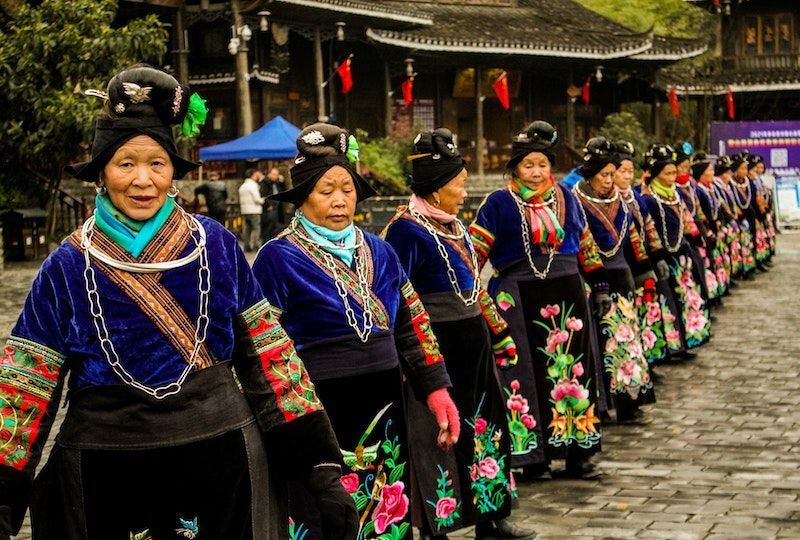The Ultimate Guide to Chinese Dialects and China's Other Spoken Languages

Many Mandarin learners have encountered difficulties when trying to explain what exactly they are learning. Is it a language? A dialect? And what's the difference between Mandarin and Chinese, anyway? If you're a bit lost, you're not alone! The simple explanation is that there are many different languages and dialects spoken in China. Many of them belong to the same language family and can be written using Chinese characters, but not all of them. Some of them can be understood by speakers of other dialects, while many are not mutually intelligible. Many words in Mandarin sound completely different in other varieties of Chinese. This guide will walk you through some FAQs, followed by introductions to major languages spoken in China. Think of it as a crash course in China's linguistic diversity!

What is the Difference Between Language and Dialect?
Many people view dialects as different versions of the same language, where speakers of each can understand each other. By the same token, if two speakers cannot understand each other, they must be speaking different languages. Most people assume you have to be taught to understand a different language, whereas a dialect is just a slightly different way of speaking.
The reality is a bit more complicated, though. Linguistically, there isn't much to distinguish languages from dialects. In fact, a language is typically just a dialect that has been standardized and made the official language of a place, typically a country or province. Under this definition, classifying something as a language versus a dialect has more to do with politics, provincial or national borders, and cultural unity than it does with actual linguistic similarity or difference.

Is Chinese a Language?
According to Ethnologue, there are over 300 living languages spoken in China. Some of these belong to the Chinese or Sinitic languages, while others belong to different language groups such as Mongolian and Turkic. The Sinitic language branch comprises 7-10 major sub-groups, depending on which linguist you ask. About 1.3 billion people, or 16% of the world population, speak one of the Chinese languages as their native language. China is huge with complicated geography, and many varieties of Chinese developed in relative isolation. Therefore, languages and dialects are often mutually unintelligible between geographic areas. Today, many Chinese languages are known by a name that corresponds with a modern province, e.g. 广东话 (Guǎngdōnghuà) or “Guangdong speech”. However, the borders of the language typically do not match the geographic borders of the province, thus these naming conventions are shorthand.
Standard Mandarin is the official language of China. Taiwanese Mandarin differs slightly from the version spoken on the Mainland, but speakers of the two versions have little to no trouble understanding each other. Often, when someone asks us if we speak Chinese, they are really asking if we speak Mandarin. Most people don't realize Mandarin is just one of a whole host of Sinitic languages, many of which are not mutually intelligible, though they are written using the same Chinese characters. So in that sense, Chinese characters form a unified writing system that spans many dialects and even different spoken languages.
Standard Mandarin itself is the Beijing dialect of the larger Mandarin language group. The Chinese central government chose it as the standard, national language in the 1930s, elevating it above the other varieties of Chinese language. The government terms all other branches of the Sinitic language family as "dialects", but many differ extensively from Mandarin and are languages in their own right. For example, Mandarin and Cantonese are more different than Spanish and Italian: just because you know one will not enable you to speak or understand the other.
Some parts of China and Taiwan have official languages in addition to Standard Mandarin: Tibetan in the Tibet Autonomous Region, Mongolian in Inner Mongolia, Uyghur in the Xinjiang Autonomous Region, and Cantonese and English in Hong Kong. In Taiwan, the major languages are the indigenous Formosan languages and several variants of Chinese brought by colonists: Taiwanese Hokkien and Hakka, in addition to Mandarin. Efforts to protect minority languages are fairly recent in both Mainland China and Taiwan. Both regions experience tension between the governments' push to standardize communication in Mandarin but also support regional language preservation.

Varieties of Chinese Spoken in China
Mandarin | 官话 (guān huà)
Native speakers: 920 million (2017)
Also known as 普通话 (pǔtōng huà) or “common speech” on the mainland and 国语 (guóyǔ) or “national language” in Taiwan, Mandarin is the most widely-spoken language in China. The terms 中文 (zhōngwén) and 汉语 (hànyǔ) have both evolved to mainly refer to standard Mandarin as well. Mandarin originated in northern and southwestern China, but is now spoken throughout the country by around 70% of the population.
The Chinese capital has been located in the Mandarin-speaking area for most of the past millennium, making Mandarin the natural choice for a standardized, official language. It has been the primary language for government officials since the 14th century. In fact, the word “mandarin” means minister and refers to an official of the Ming and Qing dynasties, and 官话 (guān huà) means “official language”.
Standard Mandarin uses the Beijing pronunciation 儿化音 (érhuà yīn), where the “r” sound is added at the end of words. There are other, regional versions which speakers may not identify as Mandarin but which belong in the same linguistic group. For example, Sichuanese 四川话 (Sìchuān huà) differs somewhat from standard Mandarin pronunciation but is close enough that speakers of both dialects can understand each other.
Yue (Cantonese) | 粤语 (yuè yǔ)
Native speakers: 86 million (2022)
Cantonese is perhaps the most well-known dialect aside from Mandarin outside of China due to Chinese diaspora communities and Hong Kong cultural exports. It is spoken in southern China, particularly Guangdong and Guangxi provinces, and in Hong Kong and Macau. The language's English name derives from Canton, an old anglicized name for Guangzhou, the capital of Guangdong province.
广东话 (Guǎngdōng huà) or Cantonese is actually the most prominent dialect of Yue, which has a total of 10 dialects. It has six tones versus Mandarin’s four, and uses more final consonants than Mandarin. Cantonese is not mutually intelligible with other varieties of Chinese.
Wu (Shanghainese) | 吴语 (wú yǔ)
Native speakers: 81 million (2017)
The Wu language is spoken in Shanghai and throughout Zhejiang province, as well as southern Jiangsu and Anhui. The main dialect, which is now known as Shanghainese, actually originated in Suzhou around the 5th century.
Wu pronunciation is quite different from Mandarin and it uses eight tones. Speaking from personal experience, as a Mandarin learner, I find it impossible to understand Shanghainese! Chinese speakers describe Wu as sounding soft compared with northern dialects, giving rise to the idiom 吴侬软语 (Wúnóngruǎnyǔ), meaning “The tender speech of Wu”.
Min | 闽语 (mǐn yǔ)
Native speakers: 67 million
Min is spoken in Fujian, Hainan, and nearby areas. A prominent variant called Hokkien is spoken in Taiwan, as well as by overseas Chinese communities in Southeast Asia and elsewhere. Min has the most diverse range of dialects out of any Chinese language. Many of them are not mutually intelligible, perhaps because of the mountainous geography of the region which allowed many variants to develop in isolation. The Hokkien variety of Min has eight tones, and Min is not mutually intelligible with other Chinese languages or dialects.
Jin | 晋语 (jìn yǔ)
Native speakers: 63 million (2012)
Jin is spoken throughout northern China, particularly in Shanxi, Inner Mongolia, and nearby parts of Hebei, Henan, and Shaanxi provinces. It is also known as 山西话 (Shānxī huà) or “Shanxi speech” since it is spoken in almost all of Shanxi Province.
Some linguists classify Jin as a branch of Mandarin rather than its own language.
But unlike Mandarin, Jin preserves some ending consonants and does not assign a tone to those syllables.
Hakka | 客家语 (kèjiāyǔ)
Native speakers: 47.8 million (2007)
Hakka is spoken in parts of Guangdong, Fujian, and other areas of southern China. It is also spoken in parts of Taiwan, Singapore, Malaysia, and Indonesia. It originated with the Hakka people, descendants of Han Chinese who fled to southern China to escape unrest in the north beginning as early as the Western Jin dynasty (266 - 420). In fact, the word Hakka or kèjiā means “guest families”, reflecting the language’s origins in migration.
Hakka has many dialects, perhaps because the original refugees settled in remote areas. Most dialects of Hakka have six tones and are not mutually intelligible with other varieties of Chinese.
Xiang | 湘语 (xiāng yǔ)
Native speakers: 38 million (2007)
Xiang is spoken mainly in Hunan, and also in parts of Guizhou, Guangxi, and Hubei. It is also known as 湖南话 (Húnán huà) or “Hunan speech”. Many Xiang dialects have been heavily influenced by Mandarin since Mandarin-speaking areas surround the region where Xiang is spoken. Among varieties of Chinese, Xiang is one of the closest to Mandarin. It has a broader range of initial consonants than other dialects and uses five tones.
Gan | 赣语 (gàn yǔ)
Native speakers: 22 million (2018)
Gan is spoken by many people in Jiangxi, and also parts of Hunan, Hubei, Anhui, Fujian. It is also known as 江西话 (Jiāngxī huà) or “Jiangxi speech”. Gan shares many similarities with Hakka, and some linguists group the two as the Gan-Hakka languages. Gan is also partially intelligible with Wu and Mandarin. Gan languages still contain many ancient Chinese words which have fallen out of use in other varieties of Chinese.

Other Languages Spoken in China
Mongolian
Native speakers: 5.2 million (2005)
Mongolian belongs to the Mongolic language family rather than Sino-Tibetan, putting it in an entirely different language family from the Chinese varieties above. Mongolian is spoken by many of the ethnic Mongolian residents of the Inner Mongolia Autonomous Region of China. Mongolian can be written in both Cyrillic and traditional Mongolian script, although only the Mongolian script is standard in Inner Mongolia. There are several dialects of Mongolian, but Mongols tend to view themselves as one unified ethnic group dating back to their unification under Genghis Khan.
Tibetan | བོད་སྐད་
Native speakers: 8 million
Tibetan is spoken in Tibet, Bhutan, and Nepal, as well as parts of India and Pakistan. It is a branch of the Sino-Tibetan language family, just like the eight varieties of Chinese covered above. Tibetan consists of eight major groups, or 50 languages and 200 dialects. Tibetan is primarily written using Classical Tibetan, which has become prominent through Buddhist texts. The Standard or Lhasa dialect is used for broadcast in the Tibet Autonomous Region of China and is the most widely-spoken variety.
Uyghur | ئۇيغۇر تىلى
Native speakers: 8-11 million (2021)
The Uyghur language belongs to Turkic language family rather than Sino-Tibetan. It is in the same Turkic branch as Uzbek. Uyghur is spoken mainly in the Uyghur Autonomous Region (Xinjiang) in western China, where it is an official language. It is also spoken by diaspora communities in Kazakhstan, Pakistan, Kyrgyzstan, Uzbekistan and elsewhere. Uyghur is written in Perso-Arabic script, also known as the Uyghur Arabic Alphabet. Today, the language is at a high risk of extinction due to heavy pressure from the Chinese government discouraging its use.

Which Chinese Dialect Should I Learn?
At this point, you may be completely overwhelmed, wondering which language or dialect to learn. It really just depends on your goals: most people learning Chinese for professional reasons should focus on Mandarin. Since it's the official language of China, it is used in most business environments and it has the most resources for language learners. For example, Speechling offers tutoring and feedback from native Mandarin speakers. However, if your goal is to be able to understand Hong Kong cinema without subtitles, then you'll want to focus on Cantonese. If you want to work with overseas diaspora communities, then maybe Hokkien or Uyghyur would be a good fit. Although there may be fewer language-learning resources for less common languages, a quick Google search should turn up at least a few YouTube channels or podcasts, and maybe even formal academic programs! Our tips and tricks for getting the most out of your language study definitely apply, whether you want to learn standard Mandarin, Shanghainese, or Mongolian. Good luck out there!
